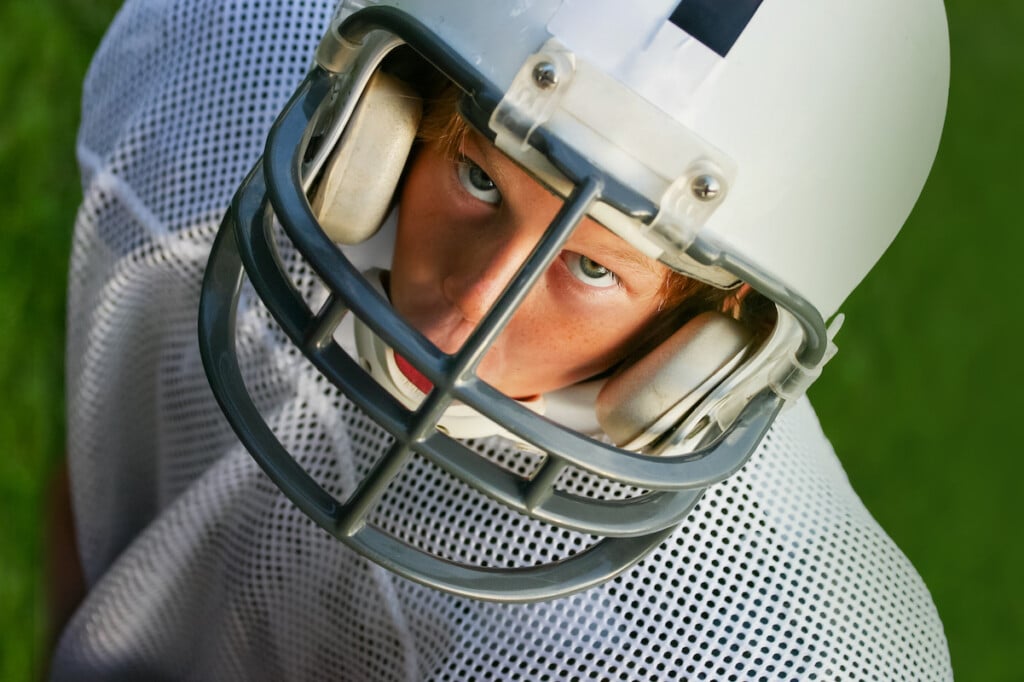Danger Comes To A Head
With fall sports in full swing, young athletes are at risk for concussion. Know the signs.

Concussions can happen any time and anywhere, but they’re a special hazard in autumn, when school sports are at their busiest. Full-contact football, soccer and field hockey can increase the potential for blows to the head. Physicians and knowledgeable coaches warn that the old-time preference for simply “shaking it off ” when a young player gets her or his “bell rung” is an attitude that belongs in a sports museum. Today we understand that concussion should be taken seriously.
“Concussions can happen on the field, especially in contact sports where athletes are exposed to forceful blows to the head or whiplash movements of the neck,” says Jason Krystofiak, M.D., primary care sports medicine physician at Monmouth Medical Center and medical director of the Matthew J. Morahan III Health Assessment Center for Athletes of RWJBarnabas Health. “But concussions can occur from more than just sports-related accidents. Home injuries can result in concussions as well. A fall off a swing set or down the stairs, a motor vehicle accident or even walking into a wall—any accident that causes head or neck injury can put someone at risk for concussion. This is why recognition of symptoms by adults, parents and coaches and immediate removal from danger is critical.”
A few to-dos:
• Recognize the injury. A concussion is a traumatic brain injury usually caused by a blow to the head. The brain normally floats inside the skull in a fluid that provides a cushion to it and the spinal cord during normal activity and movement. If the brain suddenly lurches in a certain direction, as can happen with a blow to the head, the brain can hit the skull. If you suspect that a blow to a child’s head has caused a concussion, remove him or her from the activity and carefully monitor the child, who may not always exhibit obvious symptoms. Keep in mind that forceful blows to the body, not just the head, also can result in a concussion, Dr. Krystofiak adds.
“If the child is playing football, for example, a hard tackle may ‘knock the wind’ out of someone, but the force from the whiplash movement of the neck can cause concussion too,” he says.
While monitoring the child, be on the lookout for common signs: headaches, dizziness, nausea or vomiting, balance problems and sensitivity to light or noise. In some cases, children may not recognize that something is wrong, so parents should also be on the lookout for changes in sleep pattern, fatigue, irritability and difficulty remembering or concentrating, the doctor says.
• Treat and manage symptoms. Children suspected of having a concussion while playing a sport should immediately be removed from the game and sent for medical attention. Coaches should undergo concussion management training to ensure that they can respond appropriately. An athletic trainer should track the player’s signs and symptoms and, in conjunction with a physician, create a return-to-play plan.
“Evaluation by a trainer and a physician will determine a plan for full physical and full cognitive rest,” Dr. Krystofiak says. “When you have a bruise on your arm, you’ll most likely want to rest it. With a concussion, you want the brain to rest and allow the mind and body to reset. We’ll get you back to school, back to playing gradually, little by little.”
As the brain heals, doctors and trainers will slowly incorporate time for active recovery, introducing non-contact physical activity. Kids may start with low-exertion activities such as walking, stretching and limited motion exercises.
“We’ll also make sure they have good sleep hygiene, getting seven or more hours of sleep, and monitor their hydration and nutrition,” Dr. Krystofiak adds. “Treatment and recovery is highly individualized. For example, some children may require ocular or vestibular therapy, while others may experience changes in behavior or mental health. We tackle all the pillars and make sure all phases of recovery are covered before a child returns to learn and returns to play.”
• Prevent injury. Coaches should receive concussion training and talk about concussion with players, including teaching proper technique for practice sessions and games and addressing acceptable levels of aggressiveness on the field. Equipment should be safe and in good condition, and teams should check fields for hazards that might cause falls or injury.
Parents and coaches also need to be aware of the signs of overtraining and burnout in young athletes. Pushing children too hard or placing excessive pressure on them can lead to physical and emotional exhaustion. In addition, parents and children also should discuss the dangers of sports as well as the child’s future, particularly if the young athlete has had multiple concussions.
“If someone has had five concussions and is experiencing cognitive decline,” Dr. Krystofiak says, “they may want to reconsider playing if it will impact them in their future professions.”

